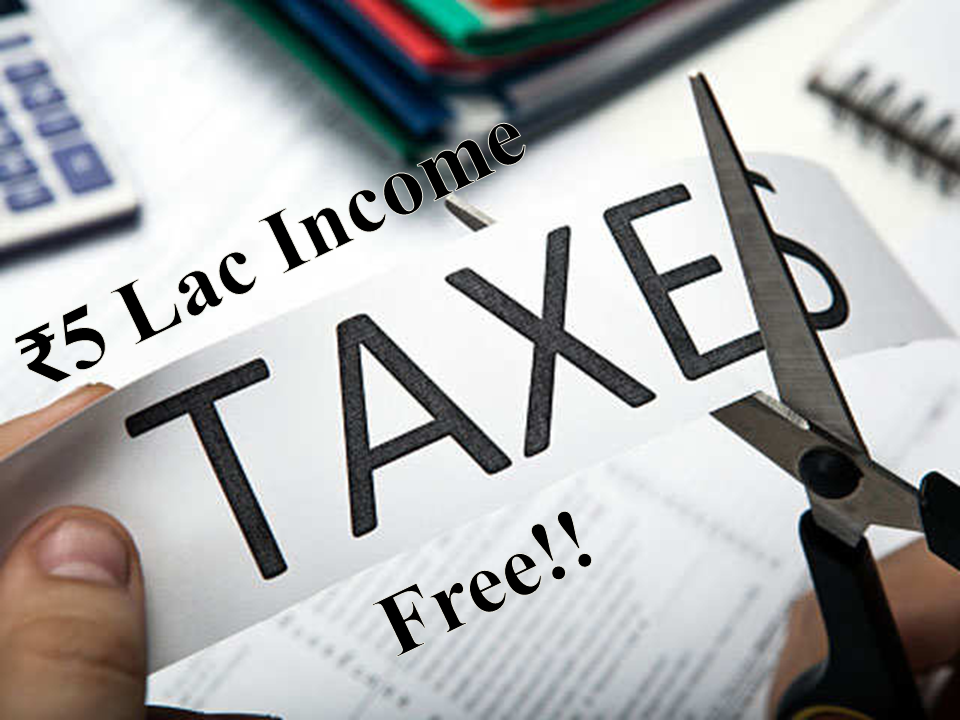Finance Minister Sh. Piyush Goyal presented the 6th and Interim Budget in Lok Sabha on 1st February 2019. The budget had brought forward a large number of positive measures for all sections of the economy, including MSMEs, startups and corporate sector. Besides, MSMEs with GST registration will 2% interest subvention on up to ₹1 crore loans.
However, the most fascinating update in this budget is that Taxpayers with annual income up to ₹5 lakhs shall pay no income tax in this financial year. Many people have misunderstood this as the increase of income tax slab rate from ₹2.5 lakh to ₹5 lakh. But, what is the truth?

Let us try to understand it here.
Table of Contents
#1. Why there is no income tax on income up to ₹5 lakhs?
- One important aspect that should be clearly understood here is that the government has given a tax rebate rather than giving clear cut exemption on income tax of up to ₹5,00,000.
- The government has slightly changed the circumstance by increasing the Rebate under section 87A of the Income Tax Act 1961.
- The Finance Minister while giving speech at the Budget Session 2019 has expressed very clearly that there won’t be any Income Tax charged on the Income up to ₹5 lakh.
- Now, in the Finance Bill 2019, it has been clearly explained how the annual income up to ₹5 lakhs is totally tax free.
#2. What is there in the section 87A of the Income Tax Act 1961?
- The Clause 8 of the Finance Bill 2019 tells us that a revision has been made to the section 87A of the Income Tax Act 1961.
- With that the individual taxpayers have been further given relief by raising the greatest amount of tax rebate to ₹12,500 from the existing ₹2,500. This tax rebate will currently be allowed to the taxpayers having annual income up to ₹5,00,000 rather than the existing ₹3,50,000.
#3. How can this be understood?
The above situation can be well understood with the help of a chart given below-
| Particulars | Case Study I | Case Study II |
| Annual Income | 5,00,000 | 5,00,100 |
| Rates of Income Tax | ||
| Income from ₹0 to 2,50,000 (0%) | Nil | Nil |
| Income from ₹ 2,50,001-5,00,000 (5%) | 12500 | 12500 |
| Income from ₹5,00,001-10,00,000 (20%) | 0 | 20 |
| Rebate given u/s 87A (-) | (-) 12500 | 0 |
| Net Tax | 0 | 12520 |
| Add: Education Cess (4%) | 0 | 501 |
| Thus, Net Tax Liability | 0 | 13021 |
#4. What do we understand from the above Case Studies?
Now, from the aforementioned Case Studies, we can now make out that-
- The government has not raised the income tax slab rates. It has now increased the amount of tax rebate that was given u/s 87A of the Income Tax Act 1961.
- The taxpayer with income up to ₹5 lakh can easily avail this rebate u/s 87A while doing his income tax return filing. Since, such taxpayer will already be paying income tax of ₹12,500 (5% of 2,50,000), on which he will avail a tax rebate of ₹12,500, hence he will pay no tax on income up to ₹5 lakh (12,500 -12,500 = 0).
- As there is no change in income tax slab rates, if now income exceeds ₹5 lakh, the tax assessee can no longer claim this tax rebate u/s 87A while income tax return filing. Such an assessee will definitely need to pay income tax on income above ₹ 2.5 lakhs.
#5. What are other business friendly measures in the Budget?
The Budget indeed contains many business friendly measures that are discussed below-
- MSMEs having GST registration will be able to avail 2% interest subvention on the business loans of up to ₹1 crore.
- Individuals having gross annual income up to ₹6.5 lakh need not pay any income tax if they make investments in provident funds and prescribed equities u/s 80c of Income Tax Act 1961.
- Direct Tax Rate for the companies have turnover above ₹250 crore has been decided to be kept at 25%.

Alex is fascinated with “understanding” people. It’s actually what drives everything he does. He believes in a thoughtful exploration of how you shape your thoughts, experience of the world.


